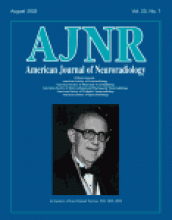Research ArticleBRAIN
Comparison of Three-Dimensional Rotational Angiography with Digital Subtraction Angiography in the Assessment of Ruptured Cerebral Aneurysms
Albrecht Hochmuth, Uwe Spetzger and Martin Schumacher
American Journal of Neuroradiology August 2002, 23 (7) 1199-1205;
Albrecht Hochmuth
Uwe Spetzger

References
- ↵Urbach H, Zentner J, Solymosi L. The need for repeat angiography in subarachnoid haemorrhage. Neuroradiology 1998;40:6–10
- ↵
- ↵Korogi Y, Takahashi M, Katada K, et el. Intracranial aneurysms: detection with three-dimensional CT angiography with volume rendering—comparison with conventional angiographic and surgical findings. Radiology 1999;211:497–506
- ↵Schievink WI, Piepgras DG, Wirth FP. Rupture of previously documented small asymptomatic saccular intracranial aneurysms: report of three cases. J Neurosurg 1992;76:1019–1024
- ↵
- ↵
- ↵Schumacher M, Kutluk K, Ott D. Digital rotational radiography in neuroradiology. AJNR Am J Neuroradiol 1989;10:644–649
- Unger B, Link J, Trenkler J, et al. Digital 3D rotational angiography for the preoperative and preinterventional clarification of cerebral arterial aneurysms. Röfo Fortschr Geb Röntgenstr Neuen Bildgeb Verfahr 1999;170:482–491
- Biederer J, Link J, Peter D, et al. Rotational digital subtraction angiography of carotid bifurcation stenosis. Röfo Fortschr Geb Röntgenstr Neuen Bildgeb Verfahr 1999;171:283–289
- ↵Tanoue S, Kiyosue H, Kenai H, et al. Three-dimensional reconstructed images after rotational angiography in the evaluation of intracranial aneurysms: surgical correlation. Neurosurgery 2000;47:866–871
- ↵Elgersma OE, Wust AF, Buijs PC, et al. Multidirectional depiction of internal carotid arterial stenosis: three-dimensional time-of-flight MR angiography versus rotational and conventional digital subtraction angiography. Radiology 2000;216:511–516
- ↵International Subarachnoid Aneurysm Trial, Trial Protocol. ISAT Trial Vessel Identification Codes. Oxford, England:1997
- ↵Hering M, Wakhloo AK, Zwicker C, et al. Multi-project angiography in the imaging of cerebral aneurysm. Aktuelle Radiol 1998;8:169–175
- ↵Anxionnat R, Bracard S, Picard L, et al. 3D Angiography first results in intracranial aneurysms. Riv Neurorad 1999;12(S2):85–87
- ↵Tu RK, Cohen WA, Maravilla KR, et al. Digital subtraction rotational angiography for aneurysms of the intracranial anterior circulation: injection method and optimization. AJNR Am J Neuroradiol 1996;17:1127–1136
- Ishihara S, Ross IB, Piotin M, et al. 3D Rotational angiography: recent experience in the evaluation of cerebral aneurysms for treatment. Intervent Neurorad 2000;6:85–94
- ↵Anxionnat R, Bracard S, Ducrocq X, et al. Intracranial aneurysms: clinical value of 3D digital subtraction angiography in the therapeutic decision and endovascular treatment. Radiology 2001;218:799–808
- Husstedt H, Trousset Y, Klisch J, Schumacher M. Precision of 3D-DSA for imaging intracranial aneurysms. Eur Rad 2000;10(S1):121
- ↵Nehls DG, Flom RA, Carter LP, et al. Multiple intracranial aneurysms: determining the site of rupture. J Neurosurg 1985;63:342–348
- Juvela S, Porras M, Poussa K. Natural history of unruptured intracranial aneurysms: probability of and risk factors for aneurysm rupture. J Neurosurg 2000;93:379–387
- ↵ISUIA. Unruptured intracranial aneurysms: risk of rupture and risks of surgical intervention—International Study of Unruptured Intracranial Aneurysms Investigators. N Engl J Med 1998; 10;339:1725–1733
- ↵Asari S, Ohmoto T. Natural history and risk factors of unruptured cerebral aneurysms. Clin Neurol Neurosurg 1993;95:205–214
- ↵
- ↵Hong KC, Freeny PC. Pancreaticoduodenal arcades and dorsal pancreatic artery: comparison CT angiography with three-dimensional volume rendering, maximum intensity projection, and shaded-surface display. AJR Am J Roentgenol 1999;172:925–931
- ↵Addis KA, Hopper KD, Iyriboz TA, et al. CT angiography: in vitro comparison of five reconstruction methods. AJR Am J Roentgenol 2001;177:1171–1176
In this issue
Advertisement
Comparison of Three-Dimensional Rotational Angiography with Digital Subtraction Angiography in the Assessment of Ruptured Cerebral Aneurysms
Albrecht Hochmuth, Uwe Spetzger, Martin Schumacher
American Journal of Neuroradiology Aug 2002, 23 (7) 1199-1205;
Jump to section
Related Articles
- No related articles found.
Cited By...
- Artificial Intelligence-Based 3D Angiography for Visualization of Complex Cerebrovascular Pathologies
- Arterial and Venous 3D Fusion AV-3D-DSA: A Novel * Approach to Cerebrovascular Neuroimaging
- Quantitative and Qualitative Comparison of 4D-DSA with 3D-DSA Using Computational Fluid Dynamics Simulations in Cerebral Aneurysms
- Retrograde 3D rotational venography (3DRV) for venous sinus stent placement in idiopathic intracranial hypertension
- Influence of observers, threshold values, and measurement methods on volumetric analysis of cerebral aneurysms with three-dimensional rotational angiography
- Diagnostic quality and accuracy of low dose 3D-DSA protocols in the evaluation of intracranial aneurysms
- Reducing radiation dose while maintaining diagnostic image quality of cerebral three-dimensional digital subtraction angiography: an in vivo study in swine
- Standard of practice: embolization of ruptured and unruptured intracranial aneurysms
- Safety of Cerebral Digital Subtraction Angiography in Children: Complication Rate Analysis in 241 Consecutive Diagnostic Angiograms
- Intracranial Aneurysms Treated With Guglielmi Detachable Coils: Imaging Follow-Up With Contrast-Enhanced MR Angiography
This article has not yet been cited by articles in journals that are participating in Crossref Cited-by Linking.
More in this TOC Section
Similar Articles
Advertisement






